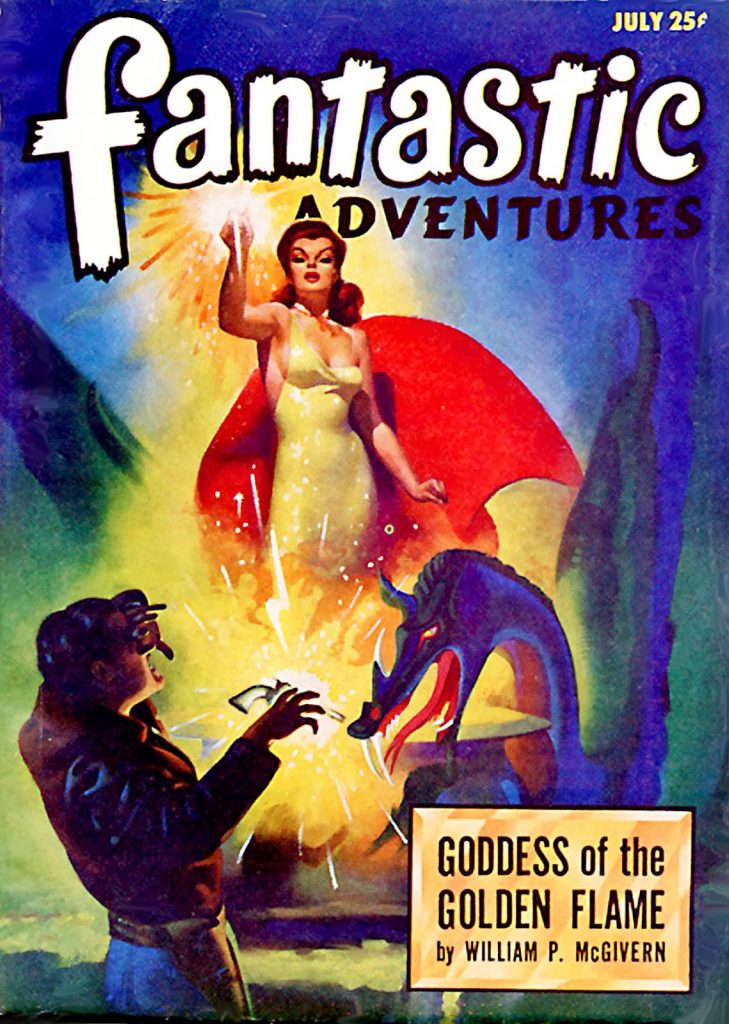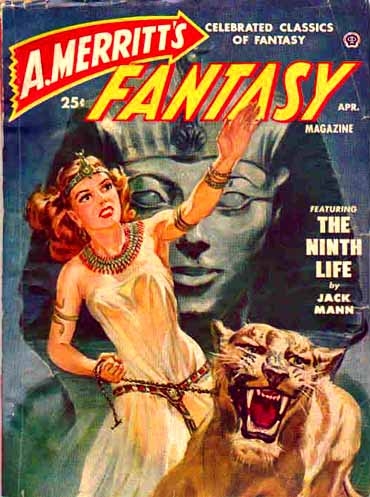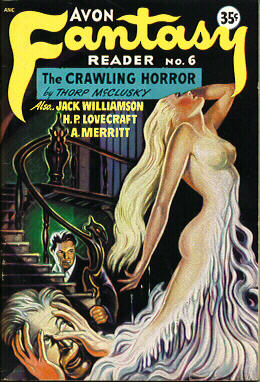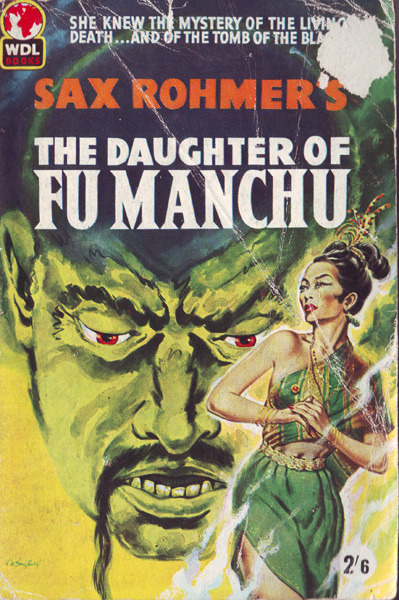SENSOR SWEEP: Awkward Gaits, Misguided Attempts, Romantic Entanglements, Seductive Evil Priestesses
Monday , 1, May 2017 Sensor Sweep 6 Comments Appendix N (Nixon Now) The Creepy Doll — “You can’t talk about creepy dolls without invoking the ‘uncanny valley’, the unsettling place where creepy dolls, like their robot cousins, and before them, the automatons, reside. The uncanny valley refers to the idea that human react favorably to humanoid figures until a point at which these figures become too human. At that point, the small differences between the human and the inhuman – maybe an awkward gait, an inability to use appropriate eye contact or speech patterns – become amplified to the point of discomfort, unease, disgust, and terror.”
Appendix N (Nixon Now) The Creepy Doll — “You can’t talk about creepy dolls without invoking the ‘uncanny valley’, the unsettling place where creepy dolls, like their robot cousins, and before them, the automatons, reside. The uncanny valley refers to the idea that human react favorably to humanoid figures until a point at which these figures become too human. At that point, the small differences between the human and the inhuman – maybe an awkward gait, an inability to use appropriate eye contact or speech patterns – become amplified to the point of discomfort, unease, disgust, and terror.”
D&D (Cirsova) Saving Throws, Pulp Heroes and D&D — “This ties back into the game theory that HP doesn’t represent actual wounds but exhaustion and the character’s ability to fight on under pressure in extreme circumstance. Of course, you also might say that it would not be very pulpy to fail your saving throw and be instantly killed, but D&D is a game, and without a genuine sense of risk, your game can end up in a boring slump where everyone knows that everyone is going to live no matter what, so why bother faking the suspense? And in those cases where your life is on the line AND YOU MAKE IT, how much more awesome is it? It makes those times when you could’ve lost your character but didn’t all the more special.”
Meanwhile… (Marzaat) Winter Tide; or Adventures in Reviewer Parallax — “There is a weakly developed plot about Marsh’s circle finding a Soviet agent who may have learned the body-switching magic featured in Lovecraft’s ‘The Thing on the Doorstep’, but mostly there is a lot of magic rituals and talk about the three races of man representing air, sea, and earth. It’s not even as interesting as August Derleth’s misguided attempt to correlate the four elements to Lovecraft’s ‘gods’.”
Appendix N (Temple of Iron) Tolkien’s Appendix N Volume II — “The tale is set in motion called the, ‘First Adventure’. Where it describes the maiden Kriemhild. She was considered the most beautiful woman in the world. Dear to all, yet wed to none. It gives us a description of the splendor of her household, the strength and honor of her brothers and father. Theirs is a small kingdom set at Worms, by the Rhine. She lived in sadness as no man could claim her.”
Tunnels & Trolls (Save Versus All Wands) 1e Tunnels & Trolls, Part 9: Combat — “Some things that would seem to be quite important are left out (movement speed and surprise). Some things are confusingly presented or ambiguous (missile fire). And I could have used a bit more explanation or examples – how should shock combat be handled, exactly, and how precisely would a good tunnel master ‘break up’ mass combats into separate units? But it’s hard to fault a 43 page booklet for not including everything. And, of course, relative to the notoriously abstruse and incomplete effort in OD&D’s Men & Magic, the combat portion of 1st edition Tunnels & Trolls is an air-tight lawyer’s document.”
Movies (Kairos) They Hate Us a Lot — “There was also a degree of respect for the audience. It was assumed that the people in the theater could use their imagination. They did not need a 20-minute sex scene to know that Bogart and Bergman were having a physical relationship. The audience was treated like adults, rather than teenagers. Hollywood often relied on high-brow culture in their films, even though their audience was mostly working class. People read more and they were expected to know about classic stories and characters from Western culture.”
Pulp Revolution (Cirsova) Half-Review of Tarzan at the Earth’s Core — “Generally, I believe, that authors submitted full novels to be serialized. The original Tarzan was seen as such a big deal, though, that the magazine said ‘We’re publishing this all in one go!’ A lot of times when writing longer works with the pulp mindset, writers would make sure that each chapter was self-contained with rising and climactic action, leaving one with a ‘What will happen next?!’ in part because it made their stories easier for editors to serialize.”
 Movies (Welcome to Arhyalon) The Pinching Shoe That Is Beauty and the Beast — “Anything dainty, feminine, or gentle that Belle did, any time a male character might have been in charge, had to be removed or dealt with badly. Belle could not handle Gaston subtly, while being amused and above the fray, as in the original. She had to be angry and bossy. She couldn’t look lovely in a long skirt. She has to wear modern boots, which jarred me out of the picture every time I saw them—though it took me a while to realize what was wrong—and have her skirt pinned up to show off her bloomers on one leg in an outfit that the real Belle would never have worn.”
Movies (Welcome to Arhyalon) The Pinching Shoe That Is Beauty and the Beast — “Anything dainty, feminine, or gentle that Belle did, any time a male character might have been in charge, had to be removed or dealt with badly. Belle could not handle Gaston subtly, while being amused and above the fray, as in the original. She had to be angry and bossy. She couldn’t look lovely in a long skirt. She has to wear modern boots, which jarred me out of the picture every time I saw them—though it took me a while to realize what was wrong—and have her skirt pinned up to show off her bloomers on one leg in an outfit that the real Belle would never have worn.”
D&D (Bat in the Attic) What everybody forgets about the OSR — “No one incident prompted this essay but I follow the OSR as best as I can and I think everybody needs reminded of this aspect of the OSR. That in the end it the OSR is not about one vision, not even about Gary Gygax’s and Dave Arneson’s vision. It about the freedom to take the pieces that existed at the beginning of our hobby and assemble them into the form that YOU judge best not what some what publisher or author says is best. And it is perfectly fine that you wind up agreeing with what a particular author says like Gygax, Arneson, Mentzer, Gonnerman , Proctor, Finch, Raggi , etc.”
Appendix N (Into the Night) Appendix N Challenge: Lest Darkness Fall by L. Sprague De Camp — “De Camps characterisation was a joy though, each of the major, and most minor characters were drawn wonderfully. Simple tricks, repeating of key phrases or turns of phrase were used to wonderful effect and I have no doubt that I’ll be able to remember them for years to come. His romantic entanglements are amusing, mainly because of his attempts to get out of them! There are lots of neat little bits dotted throughout the story, moments that make you smile as you read them. Like when someone takes an arrow to the…kidney.”
Traveller (Tales to Astound) From TRAVELLER: Out of the Box to the Third Imperium — “Proto-Traveller is playing with Books 1-4, Supplements 1-4, and Adventures 1-4, using these for the rules and the sum total of what you know about the Spinward Marches and the Third Imperium. As noted below, the Imperium in the early Traveller materials was a long-lived political power in decline. It committed dark deeds, the distances between the Spinward Marches and Core mattered more, and all in all it is not the bright, shiny competent Third Imperium that came as it was developed in later decades”
Appendix N (Everyday Should be Tuesday) Throwback SF Thursday: At the Earth’s Core by Edgar Rice Burroughs — “Burroughs himself has missing link ape-men, pterodactyl-men (the dominant race of Pellucidar), gorilla-men who serve as their muscle and thralls, cave bears, dire wolves, giant sea snakes, and pterodactyls. Many of the creatures have obscure real world origins, probably because they were better known in ERB’s time than some others only discovered later.”
Pulp Revolution (Actually…) Get Pulp in Your Teeth — “The market was bulging with magazines. Significant publishers and little fly by night operations were all jostling for space on the shelves. Offset printing technology was getting cheaper, and advances in paper manufacturing were making printing a much cheaper industry than it had ever been before. Small-shop printing houses sprang up all over the place, and taking advantage of this new infrastructure people threw money at new magazines as business speculation or even just because what they wanted to see on the shelves wasn’t there yet.”
Tunnels & Trolls (Save Versus All Wands) 1e Tunnels & Trolls, Part 11: Armor — “From an aesthetic or historical point of view, the military historian, Gary Gygax set a very bad precedent with his armor types. Leaving aside the odd and ahistorical terms – ‘chain mail’ (instead of just “mail) and later in AD&D, the almost non-sensical, ‘plate mail’ – Gygax postulated a world in which different historical armor types existed side-by-side at the armor store. Mail was medieval. Plate armor was not. It came into its own during the renaissance period and after. And it was an improvement in every way over mail. It was more protective and lighter and cheaper. I doubt there ever was a time, though I could be wrong, when, say, knights went into battle with some of them wearing mail and some of them wearing plate, or even a time when mail wearing knights confronted plate wearing knights.”
 Pulp Revolution (The Mixed GM) Grateful for the Pulp Revolution — “They were just awful. There were a couple stories I enjoyed because they had potential, but the vast majority were just trash. Just third-rate pretentious literary fiction with a veneer of something ‘fantastic’ to qualify it as science fiction or fantasy. In most stories nothing interesting happened. After reading this collection, I thought to myself ‘This…this is best science fiction and fantasy of the year?’ and promptly gave up on reading most new fiction for a few years.”
Pulp Revolution (The Mixed GM) Grateful for the Pulp Revolution — “They were just awful. There were a couple stories I enjoyed because they had potential, but the vast majority were just trash. Just third-rate pretentious literary fiction with a veneer of something ‘fantastic’ to qualify it as science fiction or fantasy. In most stories nothing interesting happened. After reading this collection, I thought to myself ‘This…this is best science fiction and fantasy of the year?’ and promptly gave up on reading most new fiction for a few years.”
Meanwhile… (Marzaat) The Litany of Earth — “The story is infused with the typical liberal sf faith: there are no dangerous forms of life or aliens, just misunderstood ones, that conflicts can not be irresolvable. We are also shown the frankly nihilist faith which says there is no good or bad yet we are to find the government’s actions bad in protecting normal humans.”
D&D (Gaming While Conservative) They’re Called Modules for a Reason — “Modules are better than adventures. They force the players to play like grown ups. They force the players to make decisions and direct the play. The give the DM infinite amounts of flexibility. Go ahead and try dropping your average Dungeon adventure or Pathfinder movie-script – er, I mean ‘adventure’, yeah right – into an ongoing campaign without doing more work than you would have if you just wrote your own damn adventure.”
Tunnels & Trolls (Deluxe Tunnels & Trolls) Arena of Khazan Returns! — “One of the most unique art related things about Arena of Khazan is that all 20 of the original interior illustrations were done by Peter Laird who became the very well-known co-creator of the Teenage Mutant Ninja Turtles. Peter did only two or three RPG books before he hit the big-time, and we are proud to bring this rare collection of his pre-Ninja Turtles art back to life.”
Appendix N (Into the Night) Misplaced Writers: C.L.Moore — “Okay, I’m beginning to realise that there are some pretty serious gaps in my reading history. Gaps that just shouldn’t be there. Gaps that I wish someone had pointed out and encouraged me to fill as I was growing up. So I’m here now, listing the writers I’ve recently discovered and telling you why you should read them. I’m calling them Misplaced Writers because somehow they seem to have lost their rightful place in the history of Science Fiction and Fantasy. C.L.Moore is top of that list.”
Movies (John C. Wright) Ugly and the Beast — “It is allegedly a story about the salvific power of true love, but none of the female characters are remotely feminine. Even the very short scene in the original when Le Fou is mugging the French Maid feather duster who is then rescued boldly by Lumiere the candlestick is dropped. Because no woman can ever be shown being in need of a man. Nor shown as feminine. Belle was dressed in boots in nearly all her scenes, stomping around like Gaston with large and manly steps, and so when she appears in the ballroom scene in a gown, it merely looks absurd.”
Appendix N (RMWC Reviews) Appendix N Review: The Moon Pool — “Here is a story that starts out as a proto-Lovecraftian horror tale that makes a convincing monster out of moonlight that lives in the ruins of the island of Nan-Matal (a real place, I might add). As our scientist narrator learns about this Dweller, he accrues two other adventurers to examine the ruins and find the reason for the disappearances. Then they find the entrance to a bizarre Hollow Earth situation with super strong dwarfs, cloaks of invisibility, disintegration guns, seashell-shaped hover cars, a seductive evil priestess at war with a heroic good priestess, mysterious extradimensional gods, an undead army, and benevolent warrior frog people called the Akka.”
Comics (Ron Edwards) So not making friends here — “There does seem to be a curse upon superhero-comics done in prose. I speculate that it’s twofold: that the reader is convinced that the medium is sufficiently elevated above comics to yield superior work automatically, and thus becomes more than usually uncritical; the writer is convinced that minimal standards of actual story-writing need not apply because ‘it’s just comics,’ and thus busts out the worst version of comics at best.”
 Tunnels & Trolls (Save Versus All Wands) 1e Tunnels & Trolls, Part 12: Where Did All the Magic Items Go? — “Now, I don’t think a ‘just use your imagination’ sort of retort is sufficient here. It is only because of the example set by Dungeon’s & Dragons that we have perhaps come to assume that there is this obvious and almost infinite cornucopia of magical objects that anyone even remotely interested in fantasy would, so to speak, have floating around in his imagination. I’m not sure this is true even now, but it certainly wouldn’t have been true in 1975. It just wasn’t really in the fantasy or science fiction culture, even for the most well-read fans. To take just a few examples: Robert E. Howard’s Conan stories go easy on magic. Jack Vance has the occasional bizarre contrivance that’s more often annoying than anything else. There are some obvious magic items in Narnia and Middle-Earth but not as many as one first might assume. And so on.”
Tunnels & Trolls (Save Versus All Wands) 1e Tunnels & Trolls, Part 12: Where Did All the Magic Items Go? — “Now, I don’t think a ‘just use your imagination’ sort of retort is sufficient here. It is only because of the example set by Dungeon’s & Dragons that we have perhaps come to assume that there is this obvious and almost infinite cornucopia of magical objects that anyone even remotely interested in fantasy would, so to speak, have floating around in his imagination. I’m not sure this is true even now, but it certainly wouldn’t have been true in 1975. It just wasn’t really in the fantasy or science fiction culture, even for the most well-read fans. To take just a few examples: Robert E. Howard’s Conan stories go easy on magic. Jack Vance has the occasional bizarre contrivance that’s more often annoying than anything else. There are some obvious magic items in Narnia and Middle-Earth but not as many as one first might assume. And so on.”
Pulp Revolution (The Redoubt) Meet the Menagerie — “The literary market is a funny thing. While I butted my head against numerous brick walls trying to get the rest of my work into print, the #PulpRevolution was steadily brewing in the background. Enter, at this stage, Mr. Bryce Beattie, proprietor of the widely-read blog StoryHack. The revolution had called out to him, and like Lady Amelia herself, he was putting together a menagerie—a collection of talented ruffians, proper tools for a black task. I made the cut.”
That’s a good review of THE MOON POOL.
Regarding Mr. Boyle’s question in the comments, Merritt originally wrote the novella, “The Moon Pool”, for All-Story. It provoked such a rabid response from readers that the All-Story editor immediately commissioned a sequel — “The Conquest of the Moon Pool” — from Merritt. More fan ecstacy. Merritt thereupon stitched the two together to make a novel. This, plus the fact that this was Merritt’s first attempt at a novel, probably has much to do with the occasional clunkiness found in THE MOON POOL. That doesn’t negate the mind-blowing adventure, however.
BTW, Infogalactic doesn’t have a Moon Pool entry.
https://en.wikipedia.org/wiki/The_Moon_Pool
-
Thanks for the kind words.
Thanks, Deuce.
I think the problem I usually have with superheroes in prose is that the writers usually take a more arch approach to the concept. It’s probably bundled up with the same reason why so many popular writers can’t write straight action stories anymore.
I don’t read a lot of newer fiction but I read Larry Correia’s Hard Magic a while back and that probably came as close as any book I’ve read to getting the superhero vibe right, even though it isn’t strictly a superhero story.
“…game theory that HP doesn’t represent actual wounds but exhaustion and the character’s ability to fight on under pressure in extreme circumstance.”
Hidetaka Miyazaki (the Dark Souls guy), said he was thinking of this concept in Bloodborne. At the time of reading the interview, I thought it was a little odd, that the “damage” done by being crushed by a tremendous beast or set on fire or shot is merely mental distress. Death would naturally happen much faster than “losing the will to fight on,” IMO.
Thanks for the shoutout!